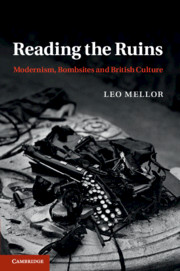Chapter 5 - The new London jungle
Published online by Cambridge University Press: 07 October 2011
Summary
The number of these flowering plants and ferns on ruined sites rose after a few seasons to 126: among them, pleasant to name if hard to distinguish – Bulbous Buttercup, Codlins-and-Cream, Musk Mimulus, Swine’s Cress, Gallant Soldiers, White Goosefoot or Fat Hen, Yorkshire Fog, Fool’s Parsley, Evening Primrose.
G. W. Stonier, ‘The Flowering Wen’ (1951)
The creation of implausibly lush zones in the midst of London was one of the most unexpected transformations that resulted from incendiary and high-explosive bomb attacks. Acts of personal endurance and survival during the Blitz itself, framed by rhetoric and stoicism, did not offer any teleology for London’s inhabitants to expect this subsequent floral revival. The blackened timbers, fallen masonry and exposed brickwork of the bombsites, markers of how the war had arrived in the city, were also habitats that the metropolis had not previously possessed. Swift colonisation of such debris by plants, through seeds carried on the wind or by birds, was remarked upon by naturalists as early as 1941. In the years that followed many bombsites became luxuriant spaces where ruins and ashes were shaded by the energetic growth of leaves and flowers. Not all inhabitants were surprised – or should have been surprised. For analogous to the pre-war concept, as imagined by modernism, of the city as a zone of fragmented destruction, literary and visual culture had proleptically envisaged the return of the wild to the metropolis.
Detailed fictional templates of how the city would revert to nature had been created from the time of the Victorians onwards; however, the effect of actually seeing the city’s ruins ‘invaded’ or ‘occupied’ by vegetation – loaded words in the wartime and postwar years – troubled and intrigued both writers and artists. The recuperative metaphorical potential in flowers springing from rubble or birds singing over blackened buildings was obvious, and it was utilised officially in posters and broadcasts – but also in more complex and ambivelent ways as inspiration for various artistic works. The complications unleashed when now deserted parts of a city reverted to a greenly fruitful state also brought complex responses, ranging through elation, menace, neurosis and dread. For while this new jungle became a haven for flora and fauna, a space for children’s games and Gothic imaginations, it was also a lawless and liminal zone.
- Type
- Chapter
- Information
- Reading the RuinsModernism, Bombsites and British Culture, pp. 166 - 202Publisher: Cambridge University PressPrint publication year: 2011

